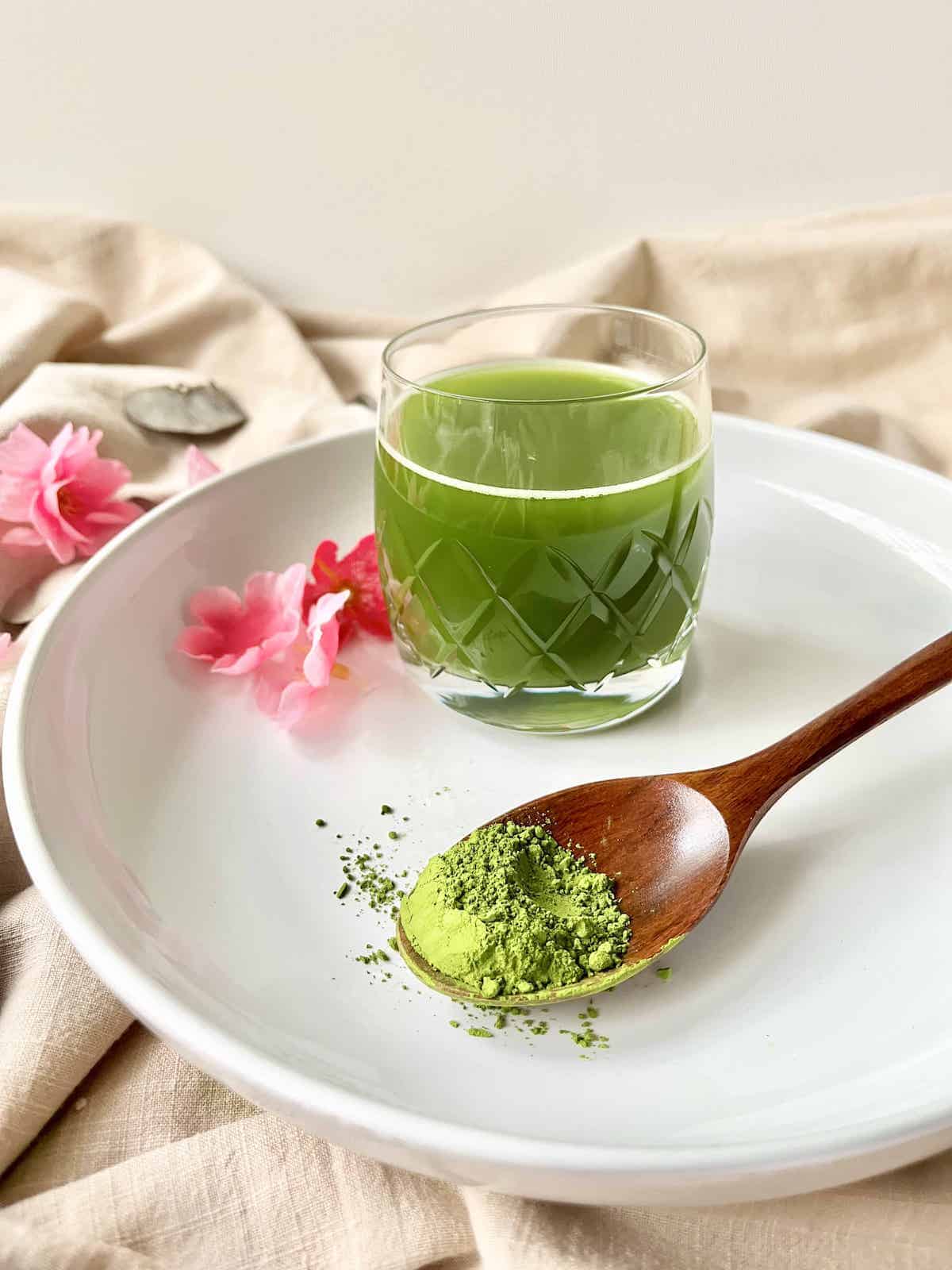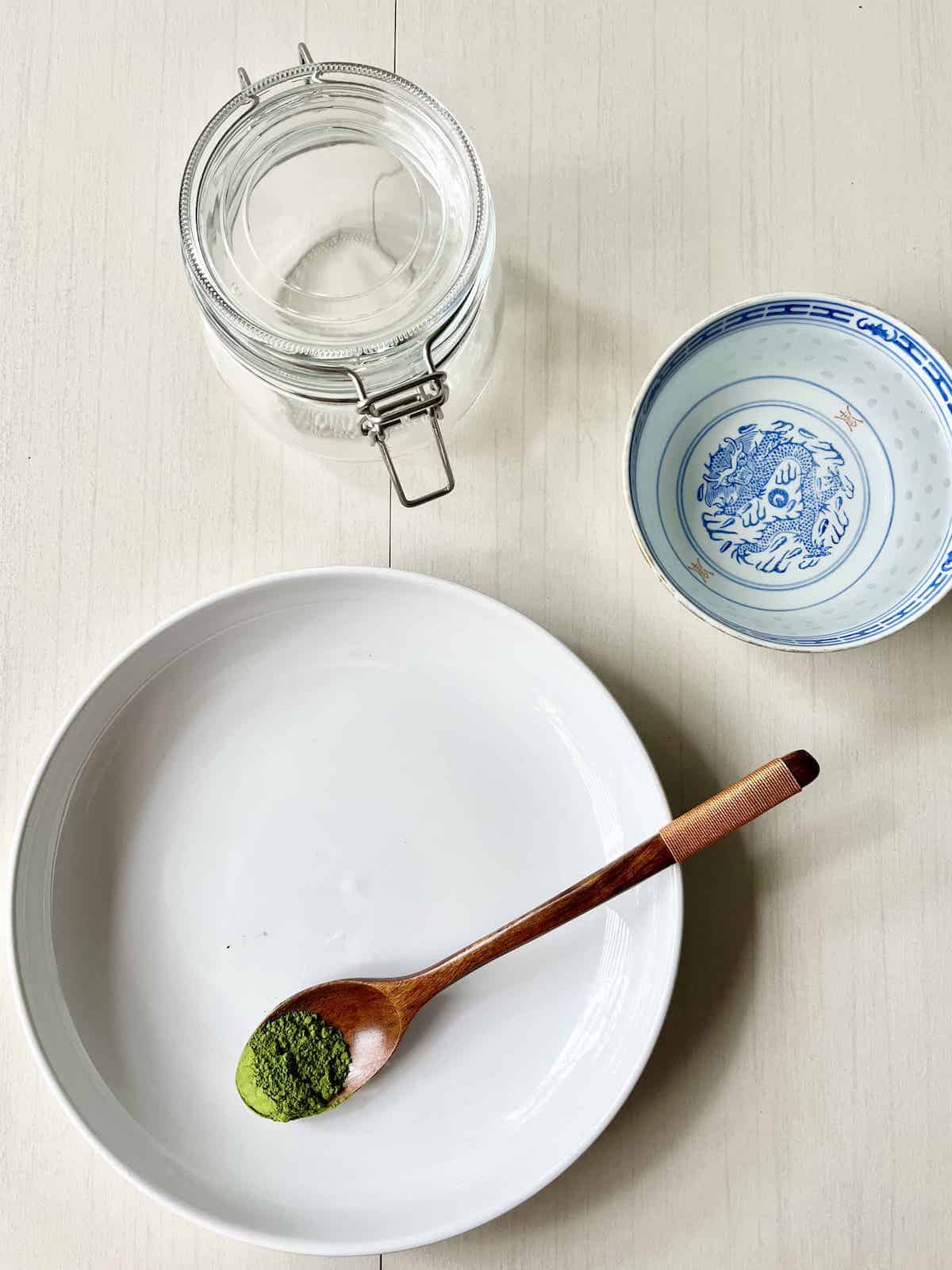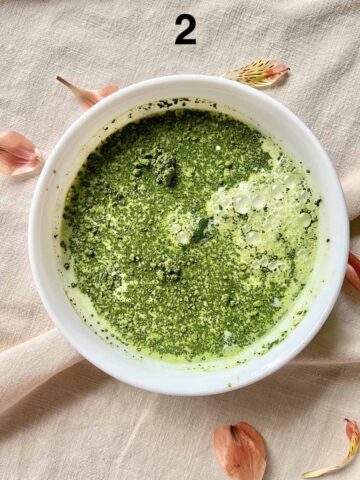Matcha vs Green Tea: a comprehensive overview of the 2 types of tea, from production, processing, appearance, taste, brewing methods, nutrition, and more!

Jump to:
Both matcha and green tea come from the Camellia sinensis plant, a plant native to East Asia, specifically China and Japan.
The plant plays a crucial role in the tea industry as it produces leaves that are rich in natural compounds such as polyphenols, catechins, antioxidants, and caffeine. These contribute to the health benefits associated with tea consumption.
The specific type of tea produced (e.g. matcha, green, oolong, black, or white) depends on how the leaves are processed after harvesting. Here is a quick summary of the differences:
- Matcha: made from young Camellia sinensis leaves. Its distinctive color and flavor result from shading the leaves before harvesting and grinding them into a powder. Matcha has a higher concentration of antioxidants and caffeine compared to green tea.
- Green tea: Made from the unoxidized leaves of the Camellia sinensis plant and known for its mild flavor as well as rich antioxidant content. Available in loose leaf or bagged form, it is less processed than other teas.
- Oolong tea: Partially oxidized, which gives this Chinese tea a flavor profile and antioxidant level between green and black tea. (Click through to learn more about the 6 different types of Chinese tea.)
- Black tea: Produced from fully oxidized leaves of the Camellia sinensis plant, it has a strong flavor and higher caffeine content than green and oolong teas.
- White tea: A delicate tea made from the young leaves and buds of the Camellia sinensis plant. It undergoes minimal processing, resulting in a mild flavor and low caffeine content.
Let's look at matcha vs green tea in more detail now!
What Is...
Green Tea

Green tea is a popular beverage that is derived from the leaves of the Camellia sinensis plant.
Although associated with Japan, the plant is native to China where it has been cultivated for thousands of years for its many health benefits. The tea leaves are carefully harvested and processed to preserve their natural flavor and nutritional content.
Like black tea, green tea is usually made by steeping green tea bags or green tea leaves in water, then consumed by drinking the cup of green tea but not the leaves. It's also a popular flavor in desserts such as matcha cookies, matcha cream cheese cake, or base for modern Asian drinks, such as green tea chai and jasmine green tea boba.
Note: Japanese green tea can often be found in the form of tea bags but Chinese green tea is typically sold as whole leaves. A popular Chinese green tea is Bilouchun.
Matcha

Matcha is a type of green tea that originates from Japan and comes in the form of a bright green powder.
It is also from Camellia Sinensis tea plants but 1 that is specially grown and processed . The plant is shade-grown for a few weeks before harvesting.
This increases its chlorophyll content and produces a vibrant green color. In addition, it inhibits the production of bitter compounds such as catechins, balancing the flavor so that matcha is faintly sweet and umami.
Some farmers even limit the sun all the way to 90%, causing the plants to grow taller to reach the sun. As a result, the leaves are more tender.
What is unique about matcha is that the entire leaf is grown into powder, which is whisked with hot water then drunk. As such, one consumes the whole tea leaf when drinking matcha.
Types of Matcha
There are 2 grades: ceremonial grade matcha and culinary grade matcha. The former is of higher quality but more expensive. It's used in the traditional tea ceremony whilst the latter is used for cooking and desserts (unless you're flush with cash, that is!)
As you can see, Matcha and Green Tea are pretty similar, so they can be used in similar ways in the kitchen. For example, there's Matcha Chai Latte as well as Green Tea Chai.
An easy way to differentiate between the 2 is the color. Can you tell which is which below?
Note: to learn about how matcha differs from hojicha, another Japanese tea, click here.
Planting, Harvesting & Processing
Matcha

The harvesting process for matcha differs from that of regular green tea.
In Japan, only the youngest and most tender leaves are handpicked for matcha. This ensures that matcha contains the highest quality and most nutrient-rich leaves from the entire plant.
After harvesting, the leaves are briefly steamed to prevent oxidation, preserving their color and nutritional value. They are then laid out to dry before being destemmed and deveined. Finally, the remaining leaf material, called tencha, is stone-ground into a fine powder.
This labor-intensive process creates the signature smooth consistency and rich flavor of matcha tea. (And is also why it is so expensive, and tastes so good in things like Matcha Nama Chocolate!)
Green Tea

The cultivation methods for green tea vary.
In Japan, some shade the plants for a short period during the final few weeks before harvest, allowing the leaves to become richer in color and flavor. This promotes the growth of chlorophyll, resulting in a vibrant green color and a unique, slightly sweet taste. (Shade-grown tea is called tencha. Matcha refers to ground tea.)
In contrast, shading is not common in China green tea production which focuses more on using terroir to influence the tea produced.
To prepare green tea, freshly harvested leaves are immediately cooked to prevent oxidation. This can be by steaming (associated with Japanese teas) or pan-firing (associated with Chinese teas.)
The process helps to preserve beneficial compounds, such as polyphenols and antioxidants, in the leaves. As such, green teas have more of these "good things" than other teas.
Appearance
When it comes to the color and appearance, matcha stands out with its vibrant green hue, while green tea has a more muted green color. The vibrant color of matcha is because it is shade-grown for a few weeks before harvesting, increasing its chlorophyll content.
In terms of texture, matcha is a fine powder made by grinding green tea leaves, whereas standard green tea normally comes in loose leaf form or bagged.
These distinct textures affect the mouthfeel and preparation methods of the two teas, with matcha offering a creamy, velvety experience and green tea providing a lighter, more delicate sensation.
Note: you can also find green tea powder these days. Generally, if the powder is duller in color, it's green tea powder. Good matcha powder should be bright green, almost fluorescent.
Taste
Both matcha and green tea come from the same Camellia Sinensis plant, but they have distinct flavor profiles.
Good Matcha has a slightly sweet, not bitter, and rich taste, with an earthy undertone. (It can taste grassy to those new to it.) It is often enjoyed with a sweetener to enhance its natural flavors.
On the other hand, green tea can have a sweet and slightly astringent taste due to its higher theophylline content.
Honestly, I find it easier to drink unsweetened green tea than unsweetened matcha!
Drink Preparation
Whisk Matcha
Matcha is traditionally sieved then whisked into a small amount of water using a bamboo whisk.
To prepare the best cup of matcha tea, you will need matcha powder, a bamboo whisk, a sifter, a bowl, and hot water. The steps are as follows:
- Sift the matcha powder through a fine mesh sieve to remove lumps. (It clumps really easily.)
- Dole out the desired amount (usually 1-2 grams) into a matcha bowl.
- Pour 2-4 ounces of hot water (160-175°F (70-80°C)) into the bowl.
- Use the bamboo whisk in a quick zigzag motion to mix the two and create a frothy, smooth tea.
Note: the powder does not dissolve in the water. It only suspends in it. If you don't drink it for a while, the green powder will settle back at the bottom of the cup.
Modern methods for those who can't afford the traditional whisk involve shaking in a Mason Jar, using an electric milk frother or blitzing in a blender. This is particularly common when making modern matcha lattes such as matcha vanilla latte, matcha strawberry latte, matcha pineapple latte and more.
Steep Green Tea
Green tea has a more delicate flavor than matcha and might taste sweet and grass-like. Steeping green tea involves using loose green tea leaves or a tea bag and hot water (approximately 160-180°F (70-80°C.) Don't use water hotter than this to avoid producing a bitter taste.) If using loose leaves, you will also need a tea infuser or teapot.
Here's how to prepare green tea:
- Place the desired amount of green tea leaves into a tea infuser or teapot. Alternatively place the tea bag in a tea cup.
- Heat water to 160-175°F (70-80°C).
- Pour the hot water over the tea leaves or tea bag, filling the teapot or cup.
- Allow the green tea to steep for 2-3 minutes before removing the infuser/ tea bag.
Note: It is important to brew the leaves for a short period of time, typically between 2-3 minutes. Overbrewing can lead to a burnt taste.
Note: in traditional Chinese tea preparation, the teapot or cup should be given a quick rinse with hot water first to warm it up. In addition, the tea is "rinsed" i.e. the 1st water poured into the pot is thrown away and not drunk. This makes the tea more aromatic.
Green tea can be enjoyed on its own, with a dash of honey, or even infused with flavors like lemon, mint, or ginger. 1 of my favorite concoctions is lychee green tea!
Nutrition
Note: please see a qualified medical professional before making any changes to your diet. All information is FYI only and not meant to be medical or diet advice.
In addition, matcha and green tea have been known to contain toxic metals such as cadmium and lead, so too much may not be good for you. It is very important to get your teas from a reputable supplier. (You'll actually take in more lead with matcha since you're drinking whole tea leaves.)
Matcha is generally thought to be healthier than green tea but is it true? Let's see:
Caffeine
Matcha typically contains more caffeine than green tea. It has about 80mg of caffeine per cup, while green tea contains around 35mg.
This difference can be attributed to the fact that matcha production preserves much of the antioxidants and amino acids in the leaves, making it a stronger source of caffeine.
Antioxidants
Both matcha and green tea are rich in antioxidants, particularly catechins. They protect the body from oxidative stress and free radical damage (associated with chronic diseases and aging.)
Matcha has a higher contraction of antioxidants than traditional green tea due to its unique planting method. For example, it contains at least 3 times the amount of EGCG (a type of catechin) as compared to popular varieties of green tea, and up to 137 times the amount of EGCG compared to certain brands of green tea.
Vitamins & Minerals
Magnesium & Manganese
Matcha and green tea both contain essential vitamins and minerals, such as magnesium and manganese.
Magnesium is important for maintaining healthy muscles, bones, and nervous system function. Manganese, in contrast, contributes to bone formation and supports the metabolism of amino acids, lipids, and carbohydrates.
As matcha is a concentrated form of green tea, it generally contains higher levels of vitamins and minerals than regular green tea.
L-theanine & Chlorophyll
L-theanine is an amino acid found in both matcha and green tea, but is more concentrated in matcha. It contributes to the calming effects of tea, as it helps reduce stress and anxiety. Matcha's high content of this amino acid, combined with its caffeine level, can provide a calm and focused energy boost.
A perfect drink for those trying to decrease their coffee intake but still needing that caffeine kick!
Chlorophyll is a green pigment found in plants. It is more abundant in matcha due to it being grown in the shade. This compound has been associated with detoxifying, as it assists in removing harmful toxins from the body.
However, note that the research done is still quite limited.
Health Benefits
Note: please see a qualified medical professional before making any changes to your diet. All information is FYI only and not meant to be medical or diet advice.
In addition, matcha and green tea have been known to contain toxic metals such as cadmium and lead, so too much may not be good for you. It is very important to get your teas from a reputable supplier. (You'll actually take in more lead with matcha since you're drinking whole tea leaves.)
Weight Loss
Both matcha and green tea have been associated with weight loss, primarily due to their high content of catechins, such as epigallocatechin-3-gallate (EGCG) as well as caffeine content. These compounds are known to boost metabolic rate and increase fat oxidation, leading to a reduction in body fat.
The higher concentration of catechins in matcha compared to general green tea might make it more effective for weight loss. However, it is essential to maintain a balanced diet and exercise routine for significant results.
Heart Health
The antioxidants present in both green tea and matcha may aid in preventing heart disease by reducing inflammation and improving blood vessels' function.
Regular consumption may help lower bad cholesterol (LDL) and triglyceride levels, promoting better blood flow through the arteries. It may also be associated with improved cardiovascular health, reducing the risk of heart disease and atherosclerosis.
Mental and Cognitive Function
Matcha and green tea contain a compound called L-theanine, which promotes mental relaxation and alertness without causing drowsiness.
This compound also stimulates the production of alpha waves in the brain, enhancing mental alertness and working memory.
The combination of L-theanine and caffeine found in both teas provides a balanced and sustained energy boost without the jitters associated with other caffeinated beverages. Consuming these teas may help improve focus, attention, and cognitive function.
Skin and Aging
The high antioxidant content in matcha and green tea helps protect the skin against damage caused by free radicals and oxidative stress. This may potentially aid in preventing premature aging by reducing inflammation and inhibiting photoaging from sun exposure.
Cancer Prevention
Inflammation and oxidative stress are linked to various chronic diseases, including cancer, cardiovascular diseases, and neurodegenerative conditions.
The catechins and antioxidants present in both green tea and matcha may help counteract some of these harmful effects by neutralizing free radicals and reducing inflammation in cells.
Regular consumption may support the body's natural defense mechanisms against these chronic conditions. However, more research is needed to establish a direct causal relationship between green tea consumption and cancer prevention.
Frequently Asked Questions
Matcha and green tea originate from the Camellia sinensis plant, but their production processes differ. Matcha contains more of the antioxidant EGCG compared to regular green tea, with at least three times the amount present in popular varieties and up to 137 times in certain brands according to Everyday Health. Both offer health benefits, but matcha's higher concentration of antioxidants, particularly EGCG, may provide more significant benefits. (Always check with a qualified medical professional before making changes to your diet!)
Matcha generally has higher caffeine levels compared to green tea due to the entire tea leaf being ground up and consumed instead of being steeped and removed like green tea. The concentration of caffeine in matcha can vary depending on the quality and preparation, but it typically offers a more sustained, less jittery energy boost compared to green tea and coffee.
Matcha has a more robust, earthy flavor profile with a smooth, velvety texture. Green tea tastes milder, lighter and more delicate, usually imparting a fresh, grassy, and sometimes slightly astringent flavor. The strength of the flavor can vary depending on the quality and preparation of each tea type. However, for a newbie to tea, I'd say green tea is much easier to get used to than matcha which can be an acquired taste, sans milk and sugar.
While both matcha and green tea offer health benefits, their unique appearances, flavors and preparation methods make them quite different from one another. Substituting one for the other may alter the taste, texture, and experience of the tea, but it's possible if one's primary goal is to reap similar health benefits. (A common reason to substitute green tea for matcha is to save money, as it's easier to find more affordable green tea.)
Any questions about green tea vs matcha? Let me know in the comments!








Comments
No Comments